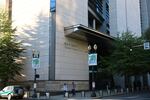
People line up to enter the federal courthouse in downtown Portland on Tuesday, Sept. 13, 2016.
Bryan M. Vance / OPB
The trial of Ammon Bundy and six other defendants accused of conspiring to prevent federal employees from doing their jobs at the Malheur National Wildlife Refuge will likely go to the jury later this week.
The defense is set to rest its case. But before that happens the team of lawyers wants to know what role paid government informants played at the refuge.
Specifically, the defense is looking for information related to a "John Killman," who they say posed at the refuge as a tactical trainer and weapons instructor.
"Various reports provided in discovery, along with defense witness interviews, document the arrival, on January 23, 2016, of a weapons instructor, expert in 'hand to hand training' and leader in defensive drills at the refuge," Tiffany Harris, standby counsel for defendant Shanwa Cox, wrote in an early Monday court filing. "'John Killman'— as he was known to the refuge occupiers — spoke with a French or South African accent."
Harris goes on to write that defense attorneys have subpoenaed a Las Vegas man who speaks with a French accent and admitted to visiting the refuge for three days, leaving on Jan. 26. The man reportedly offered what he describes as firearms "safety" classes to people at the refuge and used the alias John Killman.
Harris also wrote that Killman's Facebook profile was created in January after the occupation began and that most of his friends on the social networking site are people who occupied the refuge. Harris said in the filing that another "Confidential Human Source" said there was more shooting at the refuge Jan. 25 – that's during the time Killman was said to be there.
Harris specifically references a video the government played for the jury, taken from one of the occupiers' cellphones. It depicts heavy arms fire at the refuge boat launch. During their case, the government said it showed organized, tactical training taking place the refuge.
"The defense must be permitted to tell the jury that some of the most dramatic evidence of force, threat, or intimidation in this case was created, at least in part, by a paid government informant or agent," Haris writes. "If Mr. Killman was dispatched to the refuge, in the waning days of the occupation, to encourage refuge occupiers to engage in mock tactical drills and trainings and to fire weapons on refuge property, then the jury should be able to consider that fact."
Harris wrote that the government has declined to answer whether Killman was an informant.
Last week, prosecutors said in court the government used 15 confidential informants during the occupation. Only two are known: a San Diego, California, woman named Terri Linnell who was at the refuge from Jan. 12 to 23; and Mark McConnell, who drove Ammon Bundy from the refuge toward John Day on Jan. 26, the day Bundy was arrested. McConnell tipped off law enforcement to their location and provided a "threat assessment," according to an Oregon State Police trooper who testified in the case.
“Obviously, it’s important to us to be able to know for certain that the activities our government alleges our clients committed are not actually acts committed by government informants," said attorney Matt Schindler, hybrid counsel for defendant Ken Medenbach.
Schindler said there’s no way to know because the government hasn't revealed who the informants were.
“We have a number of weapons and a giant quantity of ammunition that the government made no effort to attribute to anyone specifically," Schindler said.
"One of our real concerns is people affiliated with the government or working for the government were people who brought these firearms to the refuge and therefore the evidence that is there that the government is using to support this notion of a threat is in fact evidence that the government created," said Schindler.
Schindler acknowledged there’s an informant’s privilege for the government to withhold information, "but I think as the trial’s developed and as we’ve seen the testimony come out, the possible significance of that has become more clear," he said. "That’s why we’re dealing with this subject now as opposed when we technically should've been dealing with it, which is before trial."
U.S. District Court Judge Anna Brown is scheduled to make a ruling on the government information issue this week.
After the defense rests, federal prosecutors will put on a rebuttal case. After that, both sides move into their closing arguments and the jury can begin deliberating.
Subscribe To 'This Land Is Our Land'
Subscribe to "This Land Is Our Land" on NPR One, Apple Podcasts or wherever you find your podcasts. Find comprehensive trial coverage at OPB.org/ThisLand.
Share your thoughts on the trial with us on Facebook and Twitter, or by emailing us directly at thisland@opb.org.
